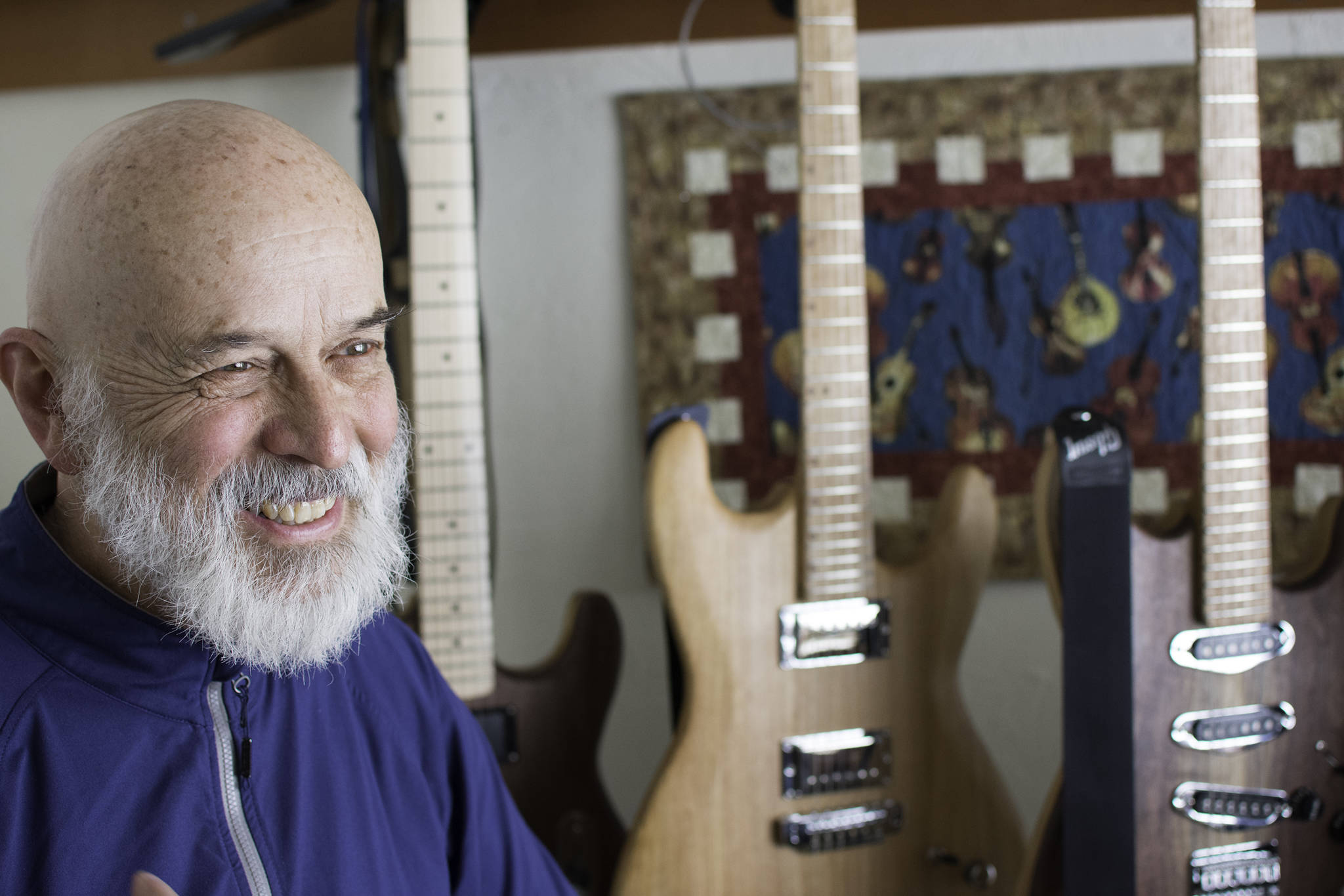A pallet, planks from an old dock in Dillingham, and a used skateboard are all things that George Gress has repurposed into guitars. He’s passionate about making his instruments sustainable and uses anything he can get his hands on, from 400-year-old spruce to simple two-by-fours.
Gress made his first guitar out of shelf boards from his son’s cabinet. The Telecaster style electric hangs on the wall of the room where he plays his guitars, adjacent to his 120th finished piece. While the Telecaster is a first attempt, with slightly wobbly lines and pieces that almost but don’t quite fit together exactly, Guitar 120 is an elegant take on a Stratocaster; it’s made out of mahogany and hollow with an f-hole reminiscent of a violin. Gress is equally proud of both.
“I’ve been experimenting with it for about three years, after making quite a few pieces of firewood,” he said with a chuckle.
When he retired, Gress’s wife, Chris, bought him some wood-working equipment in the hopes that he would make some things for around the house. He had always intended to spend his retirement learning how to play guitar, so he figured out a compromise: if he made his own guitars, he could learn how to play and use the wood-working equipment at the same time.
“When I started this, I told Chris that this would be a self-sustaining hobby: I gotta sell one to make one. I’m in over my head a little bit with these because I’ve been holding them back (for the show),” he said, gesturing to the dozen or so guitars that line his playing room.
Gress has been hoarding guitars for his third annual First Friday show, this time at the Andrew P. Kashevaroff Building at the SLAM. He has 10 guitars that he’ll be showing, as well as a three-string diddley bow and a steel guitar made out of a weathered skateboard and some old cabinet handles. Most of the guitars are made out of reclaimed or recycled materials.
When asked why he chooses to use repurposed wood, he said, “I think a lot of guitar makers are starting to do that, especially boutique makers, all over the country because the forests are disappearing. I have made a lot of yellow cedar guitars but now as the climate changes, we don’t have enough snow cover to keep the young yellow cedar alive. In the winter, they depend on a good snow cover to protect their roots while immature — we don’t have enough of that. They’re threatened which is a huge change, so we have to take care of it.”
Gress has gotten his wood from a variety of sources. The old spruce came from the Alaska Specialty Woods shop in Craig owned by Brent Cole, who specializes in sinkers, float houses, logs buried in landslides, and serves a market for sustainable, permitted woods, Gress said.
At this point, people bring him wood to repurpose. Gress has made guitars from an 80-pound plank of birch from a fisherman in Haines, reclaimed myrtle from an old shed down in Oregon, maple from the valley south of Mt. Rainier, and the aforementioned Douglas Fir from the old dock in Dillingham. When trees fall or are cut down, people bring him their willow, alder, apple, and spalted birch.
The final homes for his guitars are just as widespread as his wood sources. He keeps a map of everywhere he sends one, with pictures of each guitar tacked on. Most of the guitars are clustered in Alaska but a swathe of them are spread up the East Coast, and a few far flung tacks mark Canada, Mexico, Japan, and France. So far he has guitars in 22 states and four countries.
Gress has a cramped but functional workshop behind his house where the magic happens. He keeps his tools clean, with most of the sweet sawdust smell coming from a thin layer on the concrete floor. It’s a streamlined operation: a band saw, drill, and sanders are accompanied by a plethora of hand tools.
“I was reading the former head of Gibson Guitars, and he said, ‘Anybody with a band saw can make an electric guitar.’ I don’t believe that but that’s what he said.With electric guitars, you really can make them out of anything …The purists, the physicists say, the sound that’s picked up by the electromagnets in the pickup, the vibrations of the string, that’s all you need. You can use a two-by-four, use a muffler, you can use anything as long as you’ve got that string vibrating.”
Regardless of material, it takes him about 25 to 30 hours to make a guitar. The more complicated designs, such as an acoustic guitar or an electric neck-through where the neck and body are one piece, can take up to 60 hours to complete. For Gress, who balances his guitar-making with his grandchildren, this can mean six weeks from start to finish.
This process is what he intends to talk about during his First Friday show, with the hope of teaching people about making instruments from sustainable resources.
“Mostly I’m going to be answering questions about the guitars. I don’t teach lessons or anything … but I’ll be talking about how the guitars are made and what it takes to put one together.”
Gress will play his guitars as well, about which he is, perhaps, a bit too humble. “They’ve asked me to play a little. I’m not a good player but I’ll play a little.”
• Jack Scholz is the Capital City Weekly intern.

